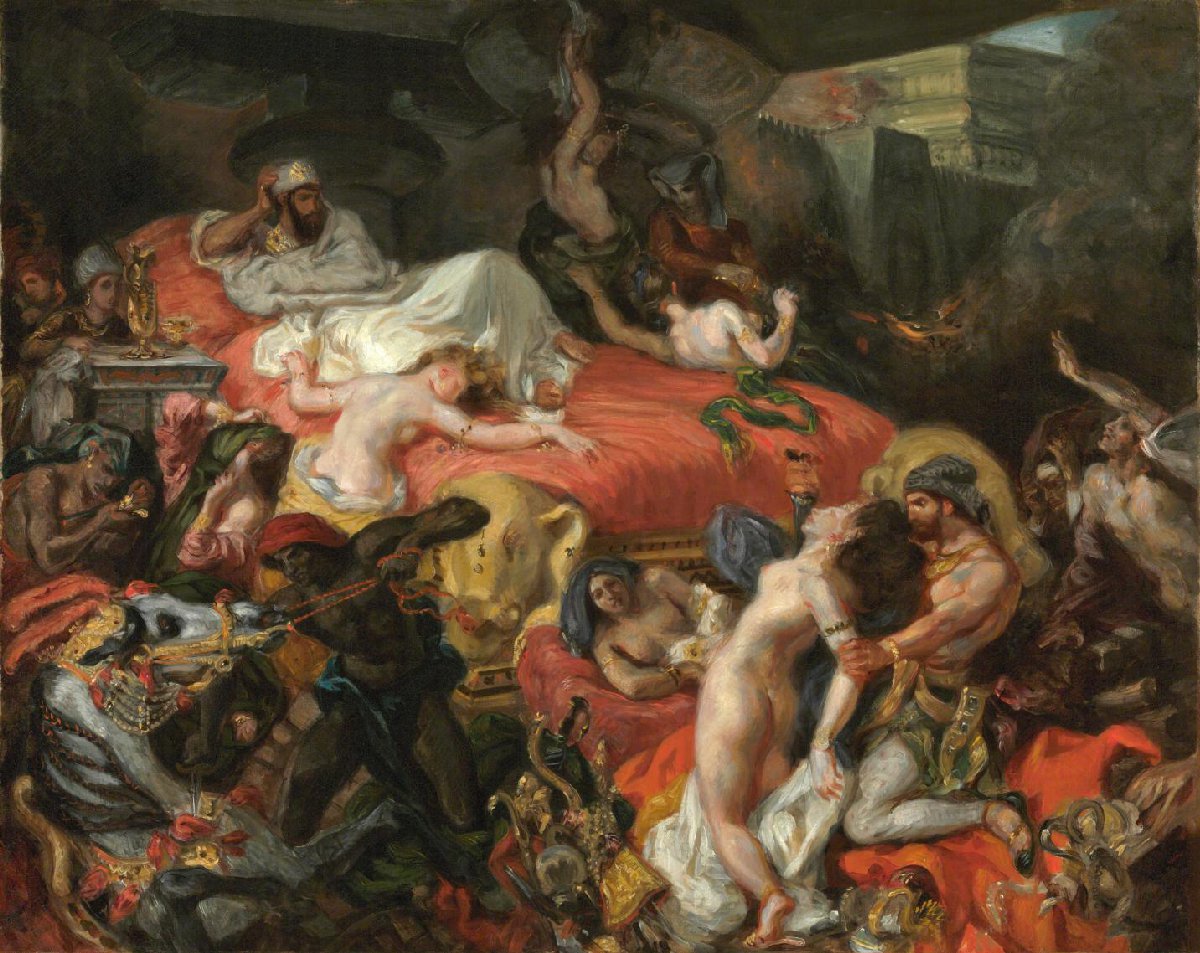
“The Death of Sardanapalus,” painted by the renowned French artist Eugène Delacroix in 1827, stands as a masterpiece that encapsulates the essence of the Romantic movement. In this monumental work, Delacroix explores the tragic demise of the last king of Assyria, Sardanapalus, blending historical narrative with vivid emotional expression. The painting, inspired by Lord Byron’s dramatic poem, unfolds a scene of dramatic intensity, rebellion against classical norms, and a departure into the realm of raw emotion. As we delve into the numerical trivia and historical facts surrounding this iconic artwork, we uncover a rich tapestry of artistic innovation, cultural influence, and the enduring legacy of one of the 19th century’s most captivating paintings.
Artist: Eugène Delacroix, born on April 26, 1798, emerged as a pivotal figure in the Romantic art movement of the 19th century. His artistic career was marked by a rebellion against the strictures of Neoclassicism, as he sought to convey raw emotion and individual expression. Delacroix’s works, including “The Death of Sardanapalus,” reflected a departure from traditional forms and techniques, earning him recognition as a leading Romantic painter. His influence extended beyond his era, impacting subsequent art movements and generations of artists.
Title and Inspiration: Titled “The Death of Sardanapalus,” Delacroix’s painting draws inspiration from Lord Byron’s dramatic poem of the same name. The narrative, rooted in the historical account of the last Assyrian king, Sardanapalus, captivated Delacroix, offering a poignant theme that resonated with the Romantic ideals of passion, excess, and impending doom. The choice of such a narrative reflects Delacroix’s penchant for infusing his art with literary and historical references, creating a multi-layered visual experience.
Historical Context: Sardanapalus, the historical figure at the heart of the painting, reigned over the Assyrian Empire during the 7th century BCE. His rule is characterized by a luxurious and decadent lifestyle, contributing to the empire’s decline. Delacroix’s choice to depict this historical episode aligns with the Romantic fascination with exotic and dramatic themes, as well as a reflection on the consequences of unchecked power and opulence.
Subject Matter: “The Death of Sardanapalus” captures a climactic moment in the Assyrian king’s life as he faces defeat by his enemies. Rather than surrendering or facing captivity, Sardanapalus chooses a dramatic act of self-destruction. He orders the destruction of his palace, concubines, horses, and wealth, symbolizing a defiant rejection of defeat. Delacroix’s portrayal of this tragic scene embodies the Romantic fascination with intense emotion and the individual’s struggle against overwhelming odds.
Size and Medium: Delacroix’s monumental painting measures 392 cm × 496 cm, creating a visually striking and immersive experience for the viewer. The use of oil on canvas, a traditional yet versatile medium, allowed Delacroix to employ expressive brushstrokes and vibrant colors, enhancing the emotional impact of the scene. The sheer size of the painting contributes to its dramatic presence, drawing viewers into the chaos and intensity of Sardanapalus’s final moments.
Exhibition: Premiered at the Paris Salon in 1827, “The Death of Sardanapalus” made a significant impact on the art world. The Salon, a prestigious annual art exhibition in France, provided a platform for artists to showcase their works to a wide audience. Delacroix’s painting, with its departure from classical norms and bold emotional content, garnered attention, sparking discussions about the evolving nature of art in the Romantic era.
Critical Reception: The initial reception of “The Death of Sardanapalus” was diverse, reflecting the divided opinions of critics. Some praised the painting for its dramatic intensity, innovation, and departure from classical norms. Others, however, criticized it for its perceived lack of adherence to traditional techniques and its divergence from established artistic conventions. This critical discourse underscores the painting’s role in challenging and redefining artistic norms of the time.
Symbolism: Delacroix’s use of symbolism in the painting is notable, particularly in the choice of colors and imagery. The intense reds and golds symbolize the impending destruction and the passionate demise of Sardanapalus. The chaotic scene, with its interplay of light and shadow, contributes to the symbolic language of the work, inviting viewers to explore layers of meaning beyond the literal narrative. This symbolic richness aligns with the Romantic emphasis on subjective interpretation and emotional engagement.
Influence on Romanticism: “The Death of Sardanapalus” stands as a quintessential example of Romantic art, embodying the movement’s rejection of classical restraint in favor of emotional expression and individualism. Delacroix’s innovative use of color, dynamic composition, and exotic themes set a precedent for Romantic artists who sought to break free from the constraints of tradition. The painting’s influence reverberated through the 19th century and beyond, leaving an indelible mark on the trajectory of art history.
Romantic Themes: Delacroix’s emphasis on emotion, passion, and the sublime in “The Death of Sardanapalus” encapsulates key themes of the Romantic movement. The painting explores the intensity of human experience, portraying the tumultuous emotions of a ruler facing imminent demise. The use of dramatic imagery and a departure from realism in favor of heightened emotion align with the Romantic fascination with the irrational, the exotic, and the extraordinary. Delacroix’s work becomes a visual manifestation of the Romantic spirit, capturing the essence of an era marked by a quest for individual expression and the sublime in art.
Visual Elements: Delacroix’s use of visual elements in “The Death of Sardanapalus” is a testament to his innovative approach to painting. The composition is marked by dynamic brushwork and a bold juxtaposition of colors, creating a sense of movement and chaos. The interplay of light and shadow enhances the dramatic impact of the scene, immersing viewers in the emotional intensity of Sardanapalus’s final moments. Delacroix’s mastery of visual elements contributes to the overall power and uniqueness of the painting, setting it apart as a seminal work in the history of art.
Assyrian Empire: Sardanapalus’s association with the decline of the Assyrian Empire adds historical depth to the painting. The Assyrian Empire, a major power in the ancient Near East, faced a complex political and military landscape during Sardanapalus’s reign. Delacroix’s choice to depict this historical episode reflects not only a fascination with exotic and ancient themes but also a broader engagement with the consequences of power, excess, and the inevitable decline of empires—an allegory that resonated with the Romantic worldview.
Historical Accuracy: While rooted in historical events, Delacroix took liberties with the accuracy of the portrayal. The painting prioritizes emotional impact over strict historical fidelity, allowing the artist to convey a more profound and universal narrative. This departure from historical accuracy aligns with the Romantic emphasis on subjective interpretation and the artist’s freedom to convey emotional truths rather than rigid historical facts.
Literary Connection: Delacroix’s decision to draw inspiration from Lord Byron’s poem adds a layer of literary richness to the painting. Byron’s narrative provided Delacroix with a compelling framework, allowing him to explore themes of excess, passion, and impending destruction. The fusion of visual and literary elements in “The Death of Sardanapalus” showcases the interconnectedness of various artistic disciplines during the Romantic era, as artists sought inspiration from literature to create emotionally charged visual experiences.
Conservation: Housed in the Musée du Louvre in Paris, “The Death of Sardanapalus” has undergone careful conservation efforts to preserve its integrity. Conservation work ensures that the painting remains accessible to future generations, maintaining its visual impact and historical significance. The meticulous preservation of the artwork speaks to its enduring importance within the cultural heritage of art institutions.
Restorations: Like many artworks with a long history, “The Death of Sardanapalus” has undergone various restorations. These efforts aim to address the natural aging of the painting, ensuring that it retains its vibrancy and original intent. Restorations also provide valuable insights into the materials and techniques used by Delacroix, contributing to the broader understanding of the artist’s practice and the evolution of the painting over time.
Contemporary Influence: The painting’s enduring influence on contemporary artists attests to its continued relevance. Delacroix’s bold departure from artistic norms and emphasis on emotional expression paved the way for subsequent movements, including Symbolism and Impressionism. Artists drawn to the emotional and symbolic depth of “The Death of Sardanapalus” have continued to explore similar themes, demonstrating the enduring impact of Delacroix’s innovative vision.
Historical Documentation: The historical accuracy of Sardanapalus’s existence and actions remains a subject of historical debate. Delacroix’s decision to depict a potentially mythical or exaggerated account adds an intriguing layer of mystery to the subject. The painting thus becomes not only a visual representation of historical events but also a reflection on the malleability of historical narratives and the artist’s role in shaping collective memory.
Orientalism: Delacroix’s incorporation of exotic and oriental elements in “The Death of Sardanapalus” reflects the Orientalist trends prevalent in 19th-century European art. The fascination with Eastern cultures, characterized by vibrant colors, luxurious fabrics, and exotic settings, was a hallmark of the Romantic era. Delacroix’s portrayal of Sardanapalus’s demise is imbued with a sense of the exotic, contributing to the broader artistic dialogue on cultural representation and the allure of the unknown.
Symbolic Colors: The symbolic use of colors in the painting adds depth to its narrative. The intense reds and golds symbolize not only the impending destruction but also the passionate and defiant nature of Sardanapalus’s character. Delacroix’s deliberate choice of color palette contributes to the emotional resonance of the scene, inviting viewers to engage with the painting on a visceral level. The symbolic language of color aligns with the Romantic belief in the power of art to evoke emotions and transcend literal representation.
Emotional Expression: Delacroix’s emphasis on emotional expression in “The Death of Sardanapalus” is a defining feature of Romantic art. The artist skillfully captures the tumultuous emotions of the moment, portraying the psychological intensity of Sardanapalus facing imminent demise. The expressive brushstrokes and vivid color contrasts heighten the emotional impact, creating a visceral connection between the viewer and the painted scene. Delacroix’s commitment to conveying raw emotion contributes to the enduring power of the painting.
Influence on Later Artists: “The Death of Sardanapalus” exerted a profound influence on later artists, particularly those associated with the Symbolist and Impressionist movements. Delacroix’s departure from traditional techniques and his emphasis on emotional intensity set a precedent for artists seeking new modes of expression. The painting’s impact can be traced through the works of artists who embraced similar themes of passion, individualism, and the sublime, marking a transformative moment in the evolution of art.
Public Reaction: The public reaction to “The Death of Sardanapalus” underscores the painting’s significance in the cultural discourse of its time. The work sparked discussions about the evolving nature of art, with some applauding its dramatic intensity and departure from classical norms, while others critiqued its divergence from established conventions. The public discourse surrounding the painting reflects the broader societal shifts and debates on the role of art in expressing complex and intense emotions.
Legacy: Delacroix’s “The Death of Sardanapalus” left an enduring legacy in the annals of art history. Beyond its immediate impact on the Romantic movement, the painting became a touchstone for subsequent generations of artists exploring themes of emotion, individualism, and the power of visual storytelling. Its legacy extends to the broader understanding of how art can shape cultural narratives and challenge established norms, making it a pivotal work in the trajectory of Western art.
Artistic Innovation: The painting’s contribution to artistic innovation is paramount. Delacroix’s bold departure from traditional techniques and his embrace of emotional intensity marked a turning point in the evolution of art. “The Death of Sardanapalus” exemplifies the Romantic spirit’s emphasis on individual expression and the exploration of powerful, often irrational, emotions. This artistic innovation resonated beyond the 19th century, influencing subsequent movements and contributing to the ongoing dialogue about the transformative power of art in capturing the complexities of the human experience. The painting remains a testament to the enduring ability of art to challenge, inspire, and shape the course of cultural and artistic evolution.









